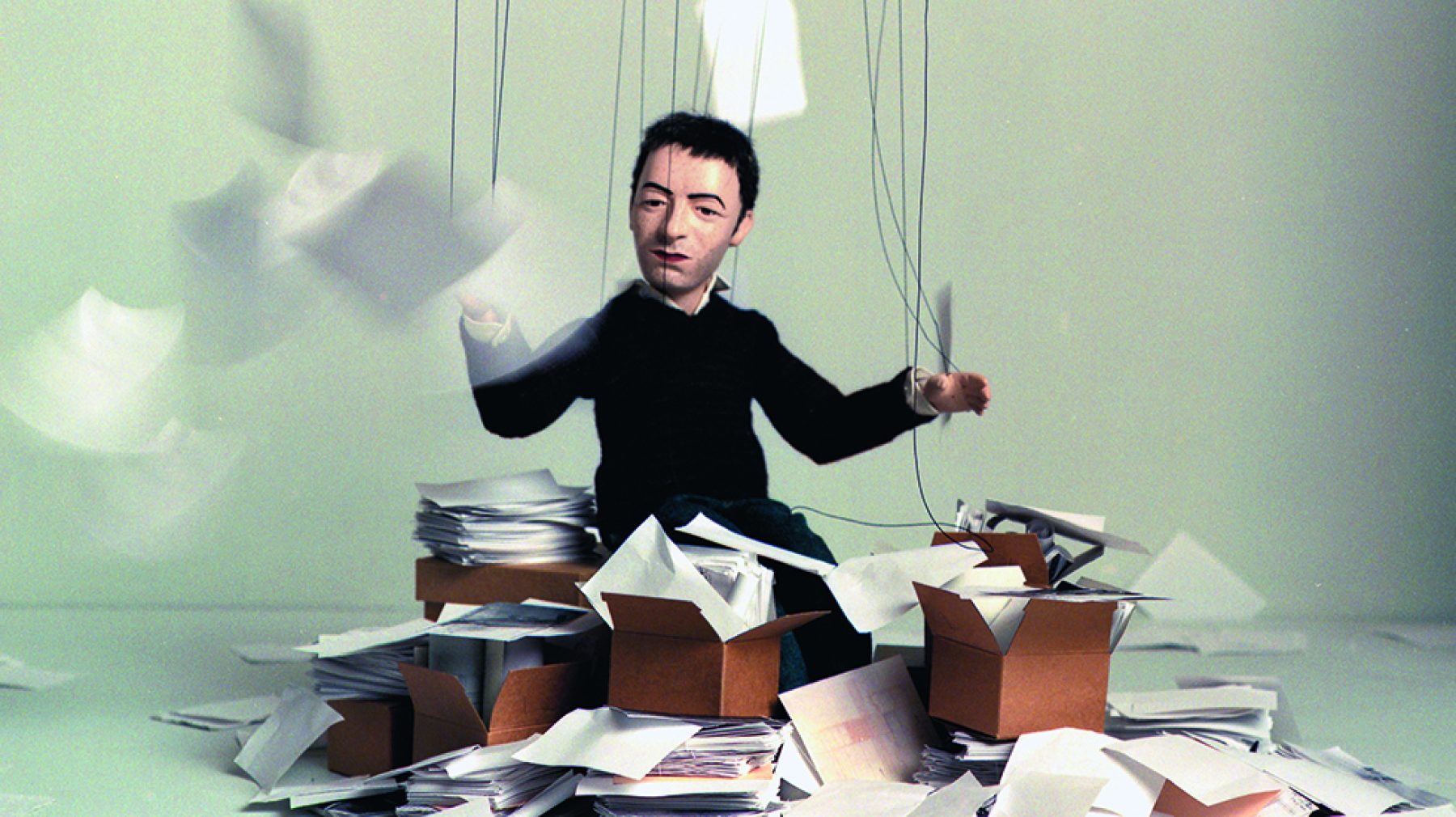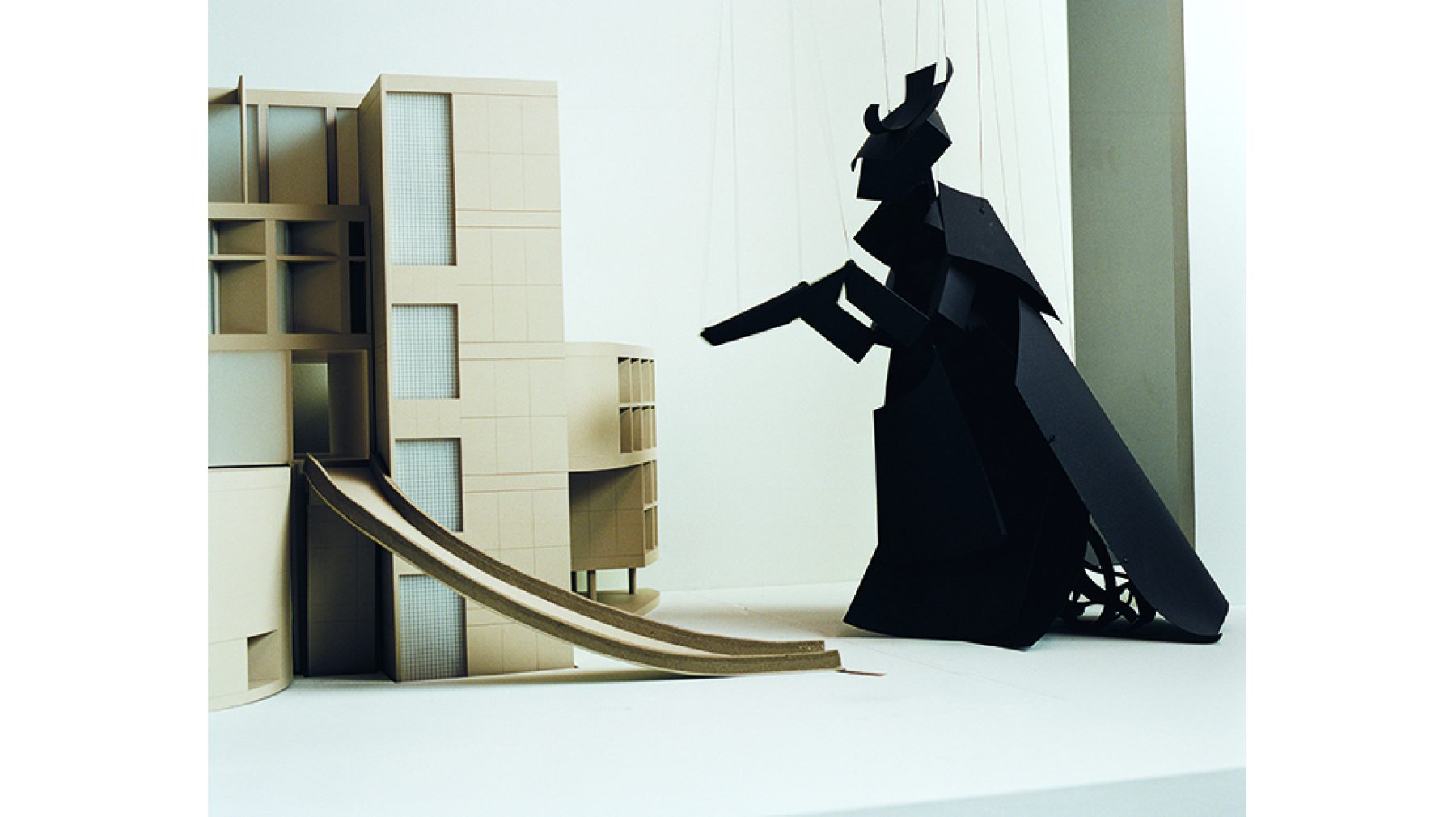This program happened on November 19, 2004.
Huyghe + Corbusier: Harvard Project

Pierre Huyghe, This is not a time for dreaming, 2004. Live puppet play and super 16mm film, transferred to DigiBeta. 24 minutes, color, sound. Courtesy Marian Goodman Gallery, New York/Paris. Photo credit: Michael Vahrenwald.
Pierre Huyghe will create a multi-media project for Harvard University as part of an inter-faculty collaboration among the Harvard University Art Museums, The Harvard Design School, and Harvard’s Department of Visual and Environmental Studies. Huyghe + Corbusier: Harvard Project will explore Le Corbusier’s vision for Harvard’s Carpenter Center for the Visual Arts, the only building in North America designed by the noted architect and home to the Department of Visual and Environmental Studies. The project will premiere at the Carpenter Center on November 18, 2004, and will continue in the building’s Sert Gallery through April 17, 2005.
Huyghe + Corbusier: Harvard Project will include multiple components that respond to the design history of the Carpenter Center and its relationship to Harvard:
A “puppet opera” telling the story of Le Corbusier’s commission and Huyghe’s own work at Harvard, which will feature custom-crafted marionettes of Le Corbusier and others;
A temporary architectural extension, designed by Huyghe in collaboration with faculty and students from the Harvard Design School, which will transform the Carpenter Center’s covered terrace into a theater for the puppet opera; A new film by Huyghe, based on the puppet opera, which will be screened continuously in the Carpenter Center’s Sert Gallery.
Organized by the Fogg Art Museums’ Department of Modern and Contemporary Art, the project grew from Huyghe’s long-standing interest in Le Corbusier’s work and his central role within the history of modern architecture. Huyghe + Corbusier: Harvard Project is the Fogg Art Museum’s first single-artist initiative of this scale, and it underscores the Harvard University Art Museums’ commitment to the study, teaching, and presentation of modern and contemporary art. The project also furthers the Art Museums’ role in fostering interdepartmental collaboration among Harvard scholars.
Huyghe began work on the project two and a half years ago. Over the past year he conducted workshops with students from Harvard’s Department of Visual and Environmental Studies and the Harvard Design School. In addition, he undertook a review of Harvard’s Le Corbusier archives. Huyghe + Corbusier: Harvard Project further developed from dialogue with project curators Linda Norden, associate curator of contemporary art at the Fogg Art Museum, and Scott Rothkopf, senior editor of Artforum and a Ph.D. candidate in the department of History of Art and Architecture. Through this research and collaboration with Harvard students and scholars, Huyghe gained insight into the radical nature of the Carpenter Center’s architecture in the context of the greater University campus. While exploring Le Corbusier’s designs and working with the students at the Center, Huyghe also experienced the space as a laboratory for creativity and a catalyst for the making and exploration of art at Harvard.
“This interdisciplinary initiative adds a special dimension to the experiences Harvard students have with projects marked by great creative energy and intensive research,” said Thomas Lentz, Elizabeth and John Moors Cabot Director of the Harvard University Art Museums. “The Harvard University Art Museums are dedicated not only to presenting modern and contemporary art, but also to teaching and researching these areas according to the Art Museums’ great traditions of close interaction with works of art and scholarship. Giving students the opportunity to work directly with a living artist while exploring one of this continent’s greatest architectural treasures is a potent 21st century expression of that legacy.”
Puppet Opera
Huyghe’s twenty-minute puppet opera, a fanciful recounting of the story of the Carpenter Center’s conception and construction, will be performed on November 18. The opera will be staged using custom-crafted marionettes playing the parts of Le Corbusier and other key figures involved in the creation of the building. Huyghe will interweave the narrative of these historical characters with marionettes of himself and other contemporary figures, melding past and present. The puppet opera will reveal the parallels between Le Corbusier’s creation of a home for the arts at Harvard and Huyghe’s task of creating a site-specific project within the building.
Architectural Extension
Huyghe’s puppet opera will be performed within a temporary architectural extension to the Carpenter Center designed in collaboration with Harvard Design School faculty member Michael Meredith. The theater will take the form of a “moss covered shell” emerging from beneath a below-grade space defined by the center’s covered terrace—drawing attention to the building’s design while subtly changing it. By transforming a largely unused outdoor space into the site of a theatrical event with a stage for the marionettes and audience seating, the extension will add a new function to a building designed for multiple artistic uses. The extension will be taken down following the November 18 performance.
Film
The puppet opera will serve as the basis for a major new film by Huyghe. Performed once prior to the November 18 opening, the puppet opera will be filmed with multiple cameras, then enhanced by post-production special effects. Huyghe will also incorporate footage of the Carpenter Center and Harvard into the film. The completed film will premiere in the Center’s subterranean auditorium on November 18 following that night’s performance of the puppet opera. The audience will be able to view the film through a glass wall that separates the auditorium from the lobby on the floor above, a seldom-used vantage point conceived by Le Corbusier for auditorium performances.
The film will then become the centerpiece of a multimedia installation in the Center’s third-floor Sert Gallery. It will be screened continuously throughout the project’s run, and will be the primary documentation of Huyghe’s groundbreaking work at Harvard after the project ends.
“Huyghe + Corbusier: Harvard Project explores the rich history, startling design, and wide-ranging functions of a building that has long captivated Huyghe’s imagination,” said Norden. “Through his response to Le Corbusier’s architectural vision, Huyghe illuminates the full scale of possibilities within the Center, expands its role as a creative catalyst, and sparks the exchange of new ideas across University disciplines.”
Pierre Huyghe
Pierre Huyghe uses a wide range of forms, including sculpture, film, architecture, and photography, to explore the nature of imagination and its role in shaping narratives and impacting reality. His art includes the orchestration of acted and processional real-time events and film installations that document these performances. Huyghe’s work at the Carpenter Center is in the spirit of earlier “remakes” such as The Third Memory, based on Al Pacino’s Dog Day Afternoon and the much-publicized bank robbery that precipitated Pacino’s movie. It also echoes his innovative renovation of a former Parisian butcher shop into a trendy café just behind the Pompidou Center. In each of these works, Huyghe uses the well-known elements of a cultural icon to critically examine its identity. In each case, he is as likely to ask what a work did not become as how it came to be.
Huyghe is the recipient of the 2002 Hugo Boss Prize from the Guggenheim Museum, and his work has been featured in solo exhibitions at the following museums and festivals: Neue Nationalgalerie, Berlin (2002); the Stedelijk Van Abbemuseum, Amsterdam (2001); the Museum of Contemporary Art, Chicago (2000); the 2001 Venice Biennale; and the Carnegie International in Pittsburgh (1999), among others. Huyghe was born in 1962 in Paris and currently lives in New York. He is at work on projects in Europe, China, and several American cities.
Project Sponsors
This project is made possible through the generosity of Marian Goodman; Frances and John Bowes; Étant-Donnés, the French-American Fund for Contemporary Art; the LEF Foundation, the Graham Foundation for Advanced Studies in the Fine Arts; the Graham Gund Exhibition Fund; the José Soriano Fund; and the Anthony and Celeste Meier Exhibitions Fund.

Pierre Huyghe, This is not a time for dreaming, 2004. Live puppet play and super 16mm film, transferred to DigiBeta. 24 minutes, color, sound. Courtesy Marian Goodman Gallery, New York/Paris. Photo credit: Michael Vahrenwald.

Pierre Huyghe, This is not a time for dreaming, 2004. Live puppet play and super 16mm film, transferred to DigiBeta. 24 minutes, color, sound. Courtesy Marian Goodman Gallery, New York/Paris. Photo credit: Michael Vahrenwald.


Pierre Huyghe, This is not a time for dreaming, 2004. Live puppet play and super 16mm film, transferred to DigiBeta. 24 minutes, color, sound. Courtesy Marian Goodman Gallery, New York/Paris. Photo credit: Michael Vahrenwald.

Pierre Huyghe, This is not a time for dreaming, 2004. Live puppet play and super 16mm film, transferred to DigiBeta. 24 minutes, color, sound. Courtesy Marian Goodman Gallery, New York/Paris. Photo credit: Michael Vahrenwald.
Archive
Explore more of our rich history through our archive.